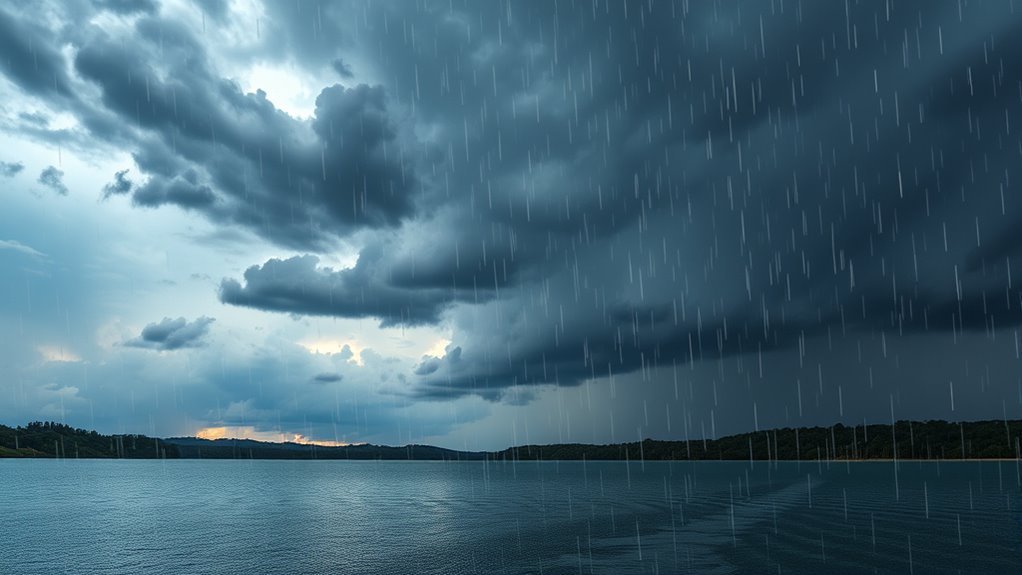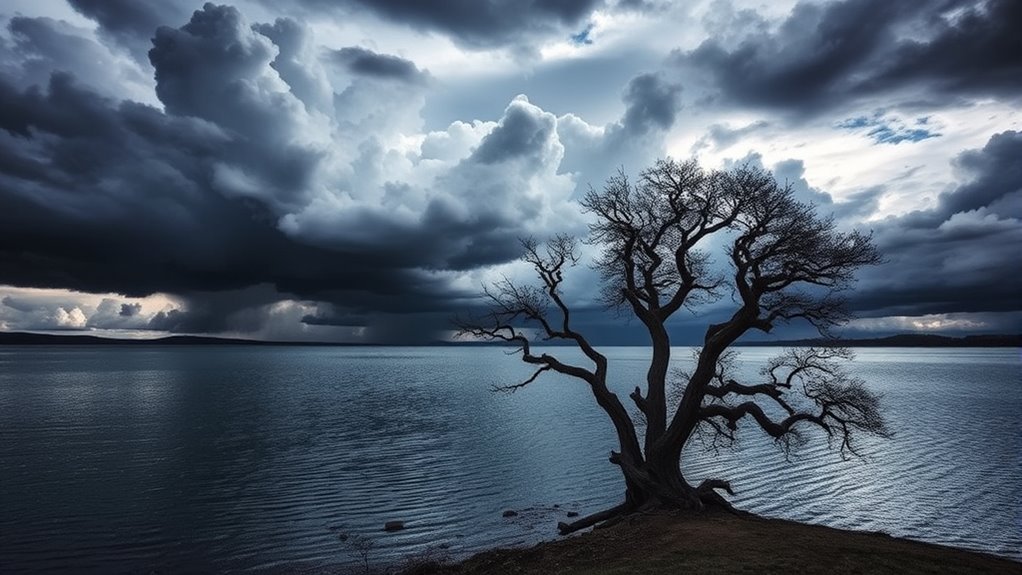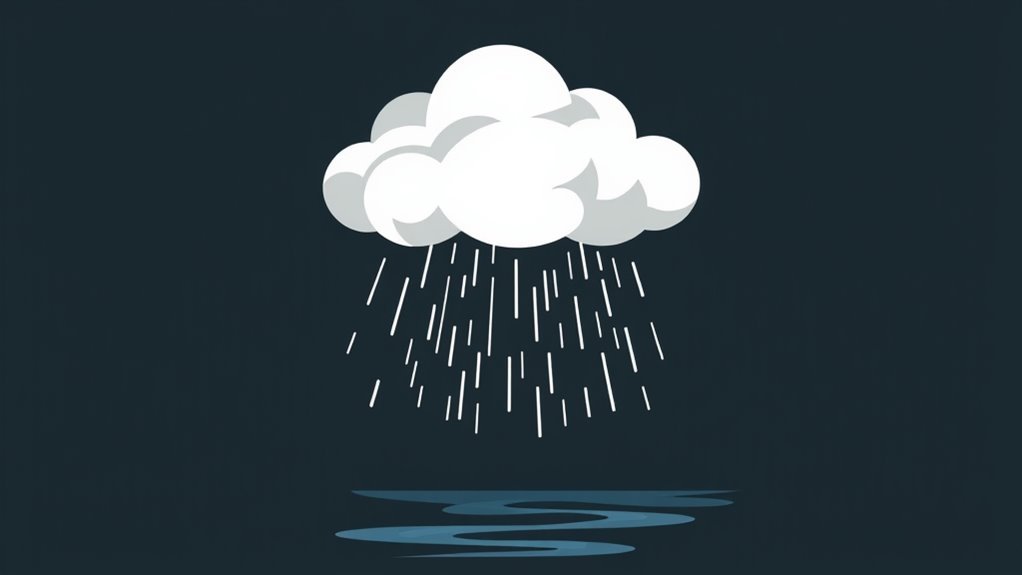Sudden downpours from squalls can cause dangerous flooding due to their intense and brief nature. These storms rapidly release large amounts of rain, often overwhelming drainage systems. The combination of warm, moist air forced upwards by cooler air leads to quick and powerful rainfall. Climate change exacerbates these conditions, increasing squall frequency and intensity. Communities need to be prepared for these events to reduce risks. Learning more about these storms can help understand their impact and necessary precautions.
Main Points
- Squalls produce intense bursts of rainfall, leading to rapid water accumulation in a short time frame.
- High humidity and atmospheric instability during squalls result in powerful updrafts, causing localized heavy rain.
- Sudden downpours can overwhelm drainage systems, increasing the risk of flash flooding in affected areas.
- Climate change contributes to more frequent squalls, exacerbating flooding risks in previously less vulnerable regions.
- Rapid rainfall rates from squalls significantly heighten flooding potential, reducing visibility and making evacuation difficult.
Understanding Squalls and Their Characteristics
Squalls are sudden, intense bursts of wind and rain that can occur within a short time frame, often leading to turbulent weather conditions. These phenomena typically develop in the context of larger storm systems, marked by sharp changes in wind direction and intensity.
Squalls can arise from various atmospheric conditions, including cold fronts, thunderstorms, or coastal influences. Their duration is usually brief, lasting anywhere from a few minutes to an hour, but their impact can be notable.
The wind speeds can reach up to 50 knots or more, causing hazardous conditions, particularly for maritime activities. Rainfall associated with squalls can be heavy, leading to reduced visibility and rapid water accumulation on roadways.
Therefore, understanding squalls is essential for weather forecasting and preparation, as their abrupt onset can pose risks for both individuals and infrastructure alike.
The Mechanism Behind Sudden Downpours

Understanding the mechanism behind sudden downpours involves examining various atmospheric conditions that contribute to squalls.
Rapid rainfall rates can result from these conditions, often exacerbated by the local terrain, which plays a vital role in the flooding that follows.
This interplay between meteorological factors and geography is essential for comprehending the phenomenon.
Atmospheric Conditions for Squalls
Sudden downpours, often defined by their intensity and brevity, occur under specific atmospheric conditions that facilitate the rapid formation of squalls.
These conditions typically include the presence of a warm, moist air mass at the surface, which is often undercut by a cooler, denser air mass aloft. This instability leads to the rapid ascent of the warm air, resulting in the development of cumulonimbus clouds.
Additionally, wind shear, or changes in wind speed and direction with altitude, can improve the organization of these storms. The convergence of surface winds can further intensify the conditions necessary for squall formation.
Collectively, these atmospheric factors create an environment conducive to sudden and intense rain events, contributing to the potential for flooding.
Rapid Rainfall Rates
Rapid rainfall rates are a defining characteristic of sudden downpours, resulting from a combination of meteorological processes. These intense bursts of precipitation can occur within a short timeframe, leading to substantial flooding.
Factors contributing to rapid rainfall rates include:
- High humidity levels: Saturated air contributes to faster condensation and cloud formation.
- Atmospheric instability: Warm air rising rapidly can create powerful updrafts, enhancing precipitation intensity.
- Localized convective cells: These small, intense storm systems can produce heavy rain over confined areas, exacerbating flooding risks.
Understanding these mechanisms is essential for predicting sudden downpours and mitigating their impacts on communities.
As climate variability continues, the frequency of such rain events may increase, making awareness and preparedness vital.
Terrain's Role in Flooding
The interplay between topography and flooding is a critical factor in the severity of sudden downpours. Variations in terrain, such as mountains, valleys, and urban structures, greatly influence how rainwater flows.
For instance, steep slopes can rapidly channel water downhill, increasing the risk of flash flooding in low-lying areas. Conversely, flat landscapes may experience prolonged water accumulation, leading to surface runoff and inundation.
Additionally, soil composition plays a role; saturated or clay-heavy soils can impede water absorption, exacerbating flooding conditions. Urbanization often compounds these effects, as impervious surfaces prevent natural drainage, directing water into drainage systems that can quickly become overwhelmed.
Understanding these topography-related dynamics is essential for effective flood management and mitigation strategies.
The Impact of Climate Change on Squall Intensity

As climate change continues to alter global weather patterns, its influence on squall intensity has become increasingly evident. Rising temperatures contribute to increased humidity levels, which in turn can improve the severity and frequency of squalls. When these intense storms form, they can lead to sudden and unpredictable downpours, resulting in hazardous flooding conditions.
- Increased squall frequency can overwhelm drainage systems.
- Higher rainfall rates contribute to rapid flash flooding.
- Warmer oceans fuel more intense storm systems.
Research indicates that regions previously less affected by squalls are now experiencing more extreme weather events.
As climate change progresses, the unpredictability of squalls and their associated rainfalls may pose considerable risks to communities, infrastructure, and ecosystems. Understanding these patterns will be essential for developing effective mitigation strategies in the face of this growing threat.
Recognizing the Signs of an Impending Squall

How can one effectively identify the signs of an impending squall? Recognizing these indicators can be vital for safety.
A noticeable drop in temperature is often the first sign, accompanied by a sudden increase in wind speed. Darkening clouds, particularly those forming into towering cumulonimbus shapes, signal that a squall may be approaching.
In addition, the atmosphere can feel charged, with an increase in humidity that is palpable. Bird activity may change as they seek shelter, and animals may become restless or anxious.
Moreover, a shift in wind direction can occur, often preceding the storm. Observing these signs can help individuals prepare for the sudden onset of a squall.
Awareness of local weather alerts and monitoring radar can also improve readiness, allowing for timely action before conditions deteriorate. Recognizing these cues is essential for minimizing risks associated with sudden weather changes.
The Dangers of Flash Flooding

While often underestimated, flash flooding poses considerable dangers that can arise with little warning. This phenomenon can transform calm surroundings into raging torrents, leading to devastating consequences. The rapid onset of flooding can overwhelm emergency services and create hazardous conditions for individuals caught unprepared.
- Swift Water Currents: Even shallow water can sweep away vehicles and people, making escape nearly impossible.
- Debris and Hazards: Floodwaters often carry debris such as tree branches and man-made materials, increasing the risk of injury.
- Limited Visibility: Heavy rainfall can reduce visibility to almost zero, complicating rescue efforts and endangering those driving or walking in affected areas.
Understanding these dangers is essential for recognizing the potential impact of flash floods. Awareness can help individuals make informed decisions and seek safety when sudden downpours occur.
Community Preparedness and Response Strategies
Effective community preparedness and response strategies are essential for minimizing the impacts of sudden downpours and flooding. Communities should prioritize the development of emergency response plans that outline clear procedures for evacuation, shelter, and resource distribution.
Regular training and simulations for emergency responders can improve their readiness to act swiftly during a flooding event.
Public awareness campaigns play a key role in educating residents about the risks and necessary precautions related to sudden downpours. This includes providing information on flood alerts, safe evacuation routes, and kit preparation.
Establishing local communication networks guarantees timely dissemination of information during emergencies.
Collaboration with local organizations and agencies is critical to guarantee a coordinated response. Engaging community members in volunteer efforts can strengthen resilience.
Long-Term Solutions to Mitigate Flood Risks
To address the increasing threat of flooding, communities must implement long-term solutions that go beyond immediate response strategies.
Effective flood mitigation requires a diverse approach that incorporates infrastructure improvements, environmental management, and community engagement.
- Invest in green infrastructure: Utilizing natural systems such as wetlands and rain gardens can absorb excess water and reduce runoff.
- Enhance drainage systems: Upgrading and maintaining stormwater management systems will improve water flow and decrease the likelihood of flooding.
- Implement land-use planning: Establishing zoning regulations that restrict development in flood-prone areas can minimize risks and protect vulnerable communities.
Common Questions
How Can I Stay Safe During a Squall?
To stay safe during a squall, individuals should seek shelter indoors, avoid driving, and monitor weather updates. They should also stay away from windows and be prepared for sudden changes in weather conditions.
What Areas Are Most Prone to Squall Flooding?
Certain geographical areas, particularly coastal regions, low-lying plains, and urban environments with inadequate drainage systems, are most prone to squall flooding, as they often experience rapid water accumulation during intense, sudden rainfall events.
Are Squalls More Common in Certain Seasons?
Squalls tend to occur more frequently during shifting seasons, particularly spring and autumn. This heightened occurrence is often linked to changing temperatures and atmospheric conditions that create instability, leading to sudden and intense weather events.
How Do Squalls Differ From Thunderstorms?
Squalls typically involve strong, sudden winds and brief heavy rain, while thunderstorms are defined by lightning, thunder, and often longer-lasting precipitation. Both can be intense, but their primary features and atmospheric conditions differ greatly.
Can Squalls Occur Without a Weather Warning?
Squalls can indeed occur without a weather warning. They may develop rapidly and unexpectedly, catching individuals off guard. This unpredictability highlights the importance of remaining vigilant, especially in areas prone to sudden weather changes.

